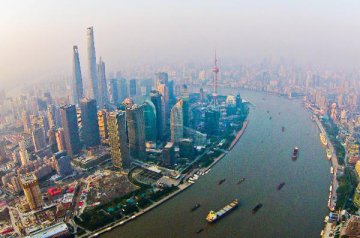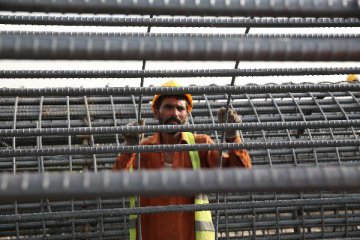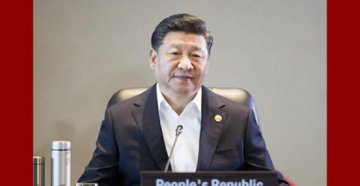by Wu Junyi, Yao Lan
HONG KONG, Sept. 8 (Xinhua) -- As the COVID-19 pandemic is still ravaging the world, major economies in the Asia Pacific region including Japan, India and Australia have witnessed negative GDP growth in the second quarter of 2020.
The International Monetary Fund (IMF) in June revised down its forecast for the global economy amid mounting COVID-19 fallout, projecting a 4.9-percent contraction in 2020.
"For the first time, all regions are projected to experience negative growth in 2020," IMF said.
JAPAN'S ECONOMIC RECOVERY FACES UNCERTAINTY
Japan, the world's third-largest economy, saw a record contraction as the global COVID-19 pandemic stifled economic activities amid restrictions under a state of emergency.
Japan's economy in the April-June period shrank an annualized real 28.1 percent from the previous quarter, downwardly revised from the 27.8 percent contraction initially reported, the government said in a report on Tuesday.
Japan imposed restrictions on business and social activities to curb the spread of the virus, with a state of emergency in place for the entire nation until being lifted on May 25.
However, the country has seen a resurgence in the number of COVID-19 cases since July. Japan had recorded over 71,000 confirmed COVID-19 cases as of Monday, compared to 16,628 cases reported on May 25.
Japanese Prime Minister Shinzo Abe's resignation on Aug. 28 adds uncertainties for Japan's recovery, posing questions on who will succeed Abe and whether the successor will follow Abe's economic policies, known as "Abenomics," which include ultra-loose monetary policy, proactive fiscal policy and a series of structural reform measures to boost the economy.
Japan's economy was on the path to slow recovery under "Abenomics," expanding for 71 consecutive months through October 2018, but the policy has not helped the country to reach the 2-percent inflation target.
Analysts believed that Abe's successor would not stay too far away from "Abenomics" as Japan's economy has earlier entered a technical recession where ultra-loose monetary policy will be hard to exit.
In addition to the pandemic, various economic and social issues, such as market shrinkage, labor shortage and slow transition to the digital age, are and will be dragging Japan's economy for a long time.
Meanwhile, there is "a risk that the leadership transition could bring about a period of policy paralysis and uncertainty, should Japan experience a run of frequent changes in premierships, as occurred prior to 2012," Fitch Ratings said in a research note.
INDIA SEES WORRISOME PICTURE
As a fallout of the pandemic-led lockdown in the country, India reported on Aug. 31 its steepest fall in headline GDP numbers by posting a 23.9-percent contraction from April to June over the same quarter last year, the first in four decades, according to the country's National Statistical Office.
India is one of the world's fastest-growing economies that once clocked annual growth of over 8 percent in 2010 and 2016.
However, the COVID-19 pandemic continues wreaking havoc in the country, with the second-highest COVID-19 caseload after the United States now, reported the highest single-day spike of 90,802 new COVID-19 cases and 1,016 deaths on Monday.
From January to March, India's GDP had grown 3.1 percent but the growth had slowed down for the entire fiscal year of 2019-20 to 4.2 percent from 6.1 percent in the preceding year of 2018-19. It has been the weakest growth since the global financial crisis.
In the first four months of the current financial year till July, India's fiscal deficit crossed the full-year budget target at 111.7 billion U.S. dollars or 103.1 percent of the budgeted target for the current fiscal year that started from April, as per the government data.
The lockdown India went through since March 25 has led to huge job losses across the country as almost all manufacturing and business activities came to a grinding halt.
According to the latest data issued by the Centre for Monitoring Indian Economy (CMIE) in August, an independent think tank, over 18 million salaried employees lost their jobs in India by July.
Global rating and research agency CRISIL India has seen a recession only thrice in the past 69 years -- in fiscals 1958, 1966 and 1980 -- all due to the monsoon-hit agriculture. "The recession staring at us today is different," it said.
The IMF in June projected an economic contraction of 4.5 percent for India as it is confronting a harsh recession accompanied by contracted GDP numbers, rising unemployment rate and hard recovery amid surging COVID-19 infections.
In the wake of an unprecedented pandemic, the government has announced monetary and fiscal measures to prop up the economy.
India's federal finance Minister Nirmala Sitharaman unveiled the fourth tranche of the 267 billion U.S. dollars economic package in May, focusing on structural reforms in several sectors including coal, minerals, defense production, airspace management, airports, power distribution companies, space and atomic energy.
The new package is equivalent to 10 percent of India's GDP.
The CMIE report cast serious doubts over the prospect of healthy economic recovery as job losses keep ballooning in the licensed organisations also known as formal sectors in India, which accounts for more than 80 percent of non-agricultural employment.
AUSTRALIA WAITING FOR LIGHTS IN DARK TUNNEL
Australia has officially fallen into its first recession in 29 years with the biggest fall in GDP on record as its economic recovery is struck by the COVID-19 resurgence and lockdown in Victoria state.
According to national accounts data published by the Australian Bureau of Statistics (ABS), the country's GDP contracted by 7 percent in the June quarter -- the largest fall since 1959.
The country's record run of avoiding major recessions -- the 1997 Asian Financial Crisis, the dot-com bubble in 2000 and the 2008 global financial crisis, has come to an end.
With non-essential businesses closed to prevent the spread of COVID-19, Australia's unemployment rate rose to 7.1 percent in May.
The number of unemployed Australians topped 1 million for the first time ever during the month of July amid the COVID-19 pandemic despite almost 115,000 jobs being created during the same period, the ABS said.
Between June and July, the national unemployment rate rose from 7.4 percent to 7.5 percent, the highest level since 1998, despite the government's biggest stimulus payout in the country's history, with a 130-billion-Australian dollar (94.6 billion U.S. dollar) JobKeeper wage subsidy program.
In addition, COVID-19 brought Australia's lucrative tourism and education industries to a halt. The ABS statistics showed that imports of services fell 50.5 percent in the June quarter and exports of services fell 18.4 percent due to the closure of Australia's borders.
Australian Prime Minister Scott Morrison described the strict stage four coronavirus restrictions put in place across Victoria state in August due to resurgence of local COVID-19 infections as a "heavy blow" for the country, which costs up to 12 billion Australian dollars (8.6 billion U.S. dollars).
Describing the road ahead as "bumpy" amid the ongoing pandemic, Australian Treasurer Josh Frydenberg said the next measures would be boosting aggregate demand, increasing flexibility in the labor market and improving training opportunities for the workforce.
"These are extraordinary and difficult times. While many people are continuing to do it tough, there are lights at the end of this tunnel," he said.
RCEP TO CONTRIBUTE TO POST-PANDEMIC RECOVERY
Southeast Asian countries are also clouded by the pandemic. The economy of the ASEAN-5 (Indonesia, Malaysia, the Philippines, Singapore, and Thailand) is projected to contract 2 percent in 2020 by the IMF in June, a sharp contrast to a rise of 4.9 percent in 2019.
"Only through international cooperation will we ease the economic and social consequences of the crisis," UN Secretary-General Antonio Guterres said in July.
Noting the "unprecedented challenges" brought by the pandemic, economic ministers of the 10 members of the Association of Southeast Asian Nations (ASEAN) and from China, Japan, South Korea, Australia, and New Zealand agreed on the necessity of open markets and joint cooperation and collaboration against COVID-19 for countries in the region.
The ministers recognized the "critical importance" of the Regional Comprehensive Economic Partnership (RCEP) in post-pandemic recovery while attending the eighth RCEP Ministerial Meeting via video conference on Aug. 27.
The RCEP, initiated by ASEAN in 2012, is a proposed free trade agreement (FTA) between the 10 member states of ASEAN and their six ASEAN FTA partners -- China, Japan, South Korea, Australia, New Zealand and India.
The 16-nation group accounts for 45 percent of the world population, 40 percent of global trade and around one-third of the world's GDP.
The ministers were "pleased with the significant progress made towards finalizing the agreement for signing" at the fourth RCEP Summit in November this year, stressing the deal's "significant role" in contributing to the growth and stability of the regional and global economy.
Vietnamese Minister of Industry and Trade Tran Tuan Anh said on Aug. 30 that member countries of the RCEP are expected to hold a meeting in October on preparation work for the deal's signing within this year.
The signing of RCEP would enhance business confidence, strengthen the regional economic architecture, and maintain the stability of the regional and global industrial chains and supply chains, as well as demonstrate the region's support for an open, inclusive, and rules-based multilateral trading system, the ministers agreed.
"Once signed, the RCEP will be the world's largest FTA by population. All countries will benefit from it," Cambodian Commerce Ministry Secretary of State and Spokesman Seang Thay said.























Latest comments